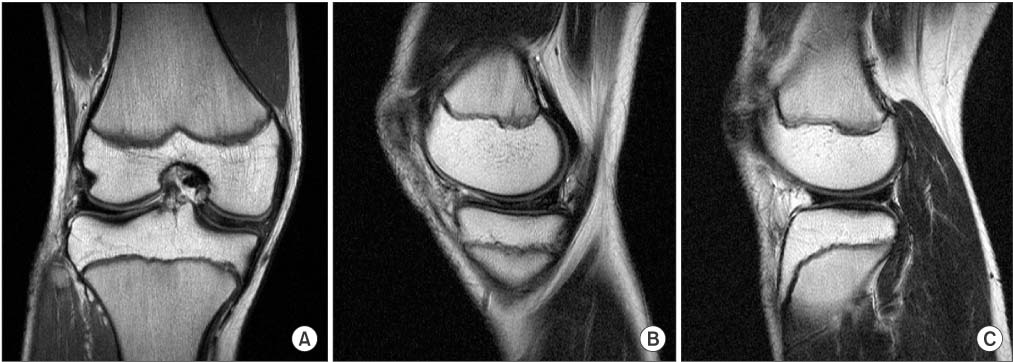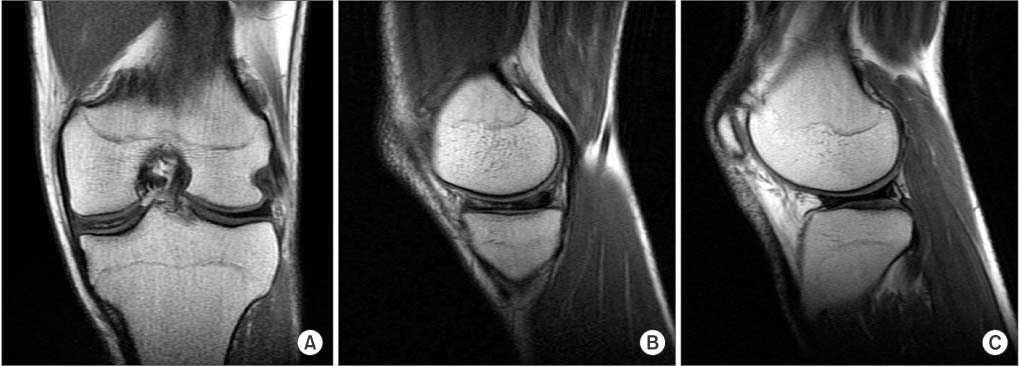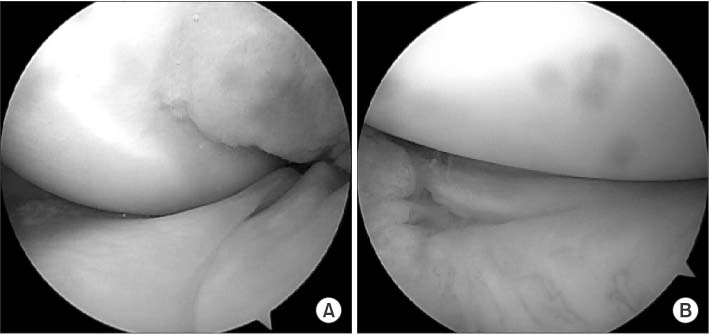J Korean Orthop Assoc.
2015 Apr;50(2):143-147. 10.4055/jkoa.2015.50.2.143.
Bilaterally Simultaneous Medial and Lateral Discoid Menisci
- Affiliations
-
- 1Department of Orthopedic Surgery, Daegu Fatima Hospital, Daegu, Korea. hwan1260@naver.com
- KMID: 2106750
- DOI: http://doi.org/10.4055/jkoa.2015.50.2.143
Abstract
- Most discoid menisci are lateral and medial discoid meniscus is very rare. Several articles have reported on bilateral lateral discoid menisci as well as bilateral medial discoid menisci, and a few articles have reported simultaneous medial and lateral discoid menisci in the same knee. Only one case of simultaneous medial and lateral discoid menisci, bilaterally, has been reported. We present another case of a male patient with bilaterally simultaneous medial and lateral discoid menisci, diagnosed with magnetic resonance imaging and arthroscopy. The patient was treated by arthroscopic partial meniscetomy.
Figure
Reference
-
1. Young RB, Cleland J, MacKay JY. The external semi-lunar cartilage as a complete disc. In : Cleland J, Mackay JY, Young RB, editors. Memoirs and memoranda in anatomy. London: Williams and Norgate;1889. p. 179–180.2. Cave EF, Staples OS. Congenital discoid meniscus: a cause of internal derangement of the knee. Am J Surg. 1941; 54:371–376.3. Jeannopoulos CL. Observations on discoid menisci. J Bone Joint Surg Am. 1950; 32:649–652.
Article4. Kim SJ, Lubis AM. Medial and lateral discoid menisci: a case report. Sports Med Arthrosc Rehabil Ther Technol. 2010; 2:21.
Article5. Smillie IS. The congenital discoid meniscus. J Bone Joint Surg Br. 1948; 30:671–682.
Article6. Yáñez-Acevedo A. Bilateral discoid lateral menisci and unilateral discoid medial menisci. Arthroscopy. 2001; 17:772–775.
Article7. Watanabe M, Ikeuchi H, Takeda S. Atlas of arthroscopy. 3rd ed. Berlin: Springer;1979. p. 88.8. Silverman JM, Mink JH, Deutsch AL. Discoid menisci of the knee: MR imaging appearance. Radiology. 1989; 173:351–354.
Article9. Yilgor C, Atay OA, Ergen B, Doral MN. Comparison of magnetic resonance imaging findings with arthroscopic findings in discoid meniscus. Knee Surg Sports Traumatol Arthrosc. 2014; 22:268–273.
Article10. Chen LX, Ao YF, Yu JK, et al. Clinical features and prognosis of discoid medial meniscus. Knee Surg Sports Traumatol Arthrosc. 2013; 21:398–402.
Article
- Full Text Links
- Actions
-
Cited
- CITED
-
- Close
- Share
- Similar articles
-
- Medial and Lateral Discoid Menisci of Both Knees
- Symtomatic Discoid Medial Meniscus: Five Cases Report
- Bilateral Discoid Medial Menisci: Two Different Types in One Patient and Bony Changes on the Medial Tibial Plateau
- Tear Pattern of Normal and Discoid Lateral Meniscus
- Anomalous Insertion of Anterior Horn of Discoid Medial Meniscus





